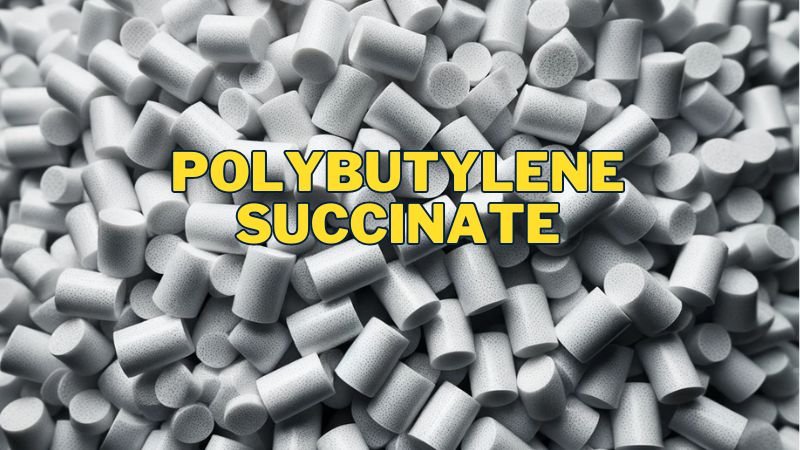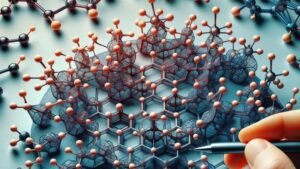Sava lalana
Polybutylene succinate (pbs) dia tsy plastika hafa ihany; Fiverenana amin'ny siansa ara-nofo maharitra izany. Amin'ny maha-indostria azy ireo amin'ny fitomboan'ny ahiahy momba ny tontolo iainana, ny fitaovana dia eo amin'ny fitaovana izay manome fiasa tsy misy andraikitra ekolojika. Ny PBS dia mifanaraka tsara amin'ity fitantarana ity. Ity lahatsoratra bilaogy ity dia mikendry ny hamakivaky izay atao hoe pbs, ny fananany, ny rindranasa, ary ny antony ahazoany fanekena amin'ny indostria isan-karazany.
Inona ny polybutylene succinate (pbs)?
Ny polybutyleNene dia manahaka ny mahazatra, izay antsoina hoe PBS, dia polyester aliphatic miaraka amin'ny rafitra simika tsy manam-paharoa izay mampiavaka azy amin'ny plastika nentim-paharazana. Tsy toy ny plastika mahazatra toy ny polyethylene na polypropylene, ny pbs dia atao amin'ny alàlan'ny polymerization ny asidra succinic ary 1,4-butaediol. Ity fanamboarana simika ity dia mandray anjara amin'ny tanjaka mekanika sy ny biodegradability.
Iray amin'ireo endri-javatra fijerena ny PBS dia ny fahaizany. Azo zahana amin'ny fomba famokarana plastika mahazatra izany, ao anatin'izany ny famolavolana tsindrona, fanakorontanana ary famoretana. Ny fitaovana dia maneho ihany koa ny fifandanjana tsara indrindra amin'ny tanjaka, ny fahamarinan-doha ary ny fanoherana ny fiatraikany. Raha ny marina, ny PBS dia mitondra ny tsara indrindra amin'ny tontolo roa: ny faharetan'ny plastika mahazatra sy ny biodegrabability amin'ny fitaovana sariaka kokoa.

Nahoana no zava-dehibe ny pbs
Ao anatin'ny tontolo iray dia mihamalalaka ny fiantraikany amin'ny tontolo iainana, PBS amin'ny maha-tetezana lehibe eo amin'ny faharetana sy ny fahombiazan'ny indostria.
Tombontsoa ny tontolo iainana
Voalohany, ny pbs dia biodegradable. Tsy toy ny plastika nentim-paharazana izay mandeha an-tsehatra, ny PBS dia mety handrava haingana kokoa rehefa miharihary ny toe-javatra mety. Ny fandinihana natao farany dia nasehon'ny pbs afaka nandevona tao anatin'ny volana vitsivitsy teo ambany fahefan'ny fametahana indostrialy, ka nahatonga azy ho safidy tsara ho an'ny vokatra tokana izay mitaky ny tsy fitovian'ny tontolo iainana tsy misy fahavoazana mandritra ny fotoana maharitra.
Toetra mekanika
Tsy momba ny ho sariaka ny pbs fotsiny; Mitanisa avo koa amin'ny fampisehoana izany. Ny fitaovana dia mampiseho tanjaka tsara, azo ampitahaina amin'ny polyethylene, izay mahatonga azy ho maharitra amin'ny fampiasana andavanandro. Ny fahamarinan-kafatra dia mamela azy hanohitra ny mari-pana isan-karazany, matetika mihoatra ny an'i Polystyrene, ka mahatonga azy ho amin'ny fampiharana ny fampiharana. Ireo toetra mekanika ireo dia tsy mihoatra ny 'maitso fotsiny’ Alternative; Ny PBS dia tena matanjaka ary afaka manolo ny plastika nentim-paharazana amin'ny fampiharana maro nefa tsy manao sorona kalitao.
| NY FANANANA | Polybutylene Succinate (PBS) | Polyethylene (PE) | Polypropylene (PP) | Polystyrene (PS) |
|---|---|---|---|---|
| Hatanjoranana (MPA) | 30-40 | 20-40 | 25-35 | 35-55 |
| Modulus flexural (GPA) | 0.8-1.5 | 0.2-15 | 1.5-2.5 | 3.0-3.5 |
| Hatanjotra fiantraikany (KJ / M²) | 3-5 | Tsy misy fiatoana | 3-16 | 2-3 |
| Ny fahitsiana mafana (° C) | -20 hatramin'ny 115 | -100 ka hatramin'ny 80 | 0 hatramin'ny 100 | -20 hatramin'ny 95 |
| Temple Transition (° C) | -30 ka hatramin'ny -20 | -100 amin'ny -80 | -10 amin'ny 0 | 90-100 |
Fampiharana ny pbs
Ny fananana tsy manam-paharoa ao PBS dia mampifanaraka tsara amin'ny indostria sy fampiharana isan-karazany. Ity ambany ity ny faritra lehibe iray izay iorenan'i PBS ny marika.
Fonosana
Miaraka amin'ny tanjaka tsara sy ny biodegradability, pbs dia safidy tsara ho an'ny fitaovana fonosana. Tena malaza amin'ny fonosana sakafo izay misy ny filaminan'ny fiarovana sy ny saro-pantarina.
Sarimihetsika fambolena
Ny biodegradability pbs dia mahatonga azy io ho tsara indrindra ampiasaina amin'ny sarimihetsika fambolena. Ireo sarimihetsika ireo dia azo avela ho simba amin'ny saha, mampihena ny fako sy ny asa tafiditra ao amin'ny fanesorana azy ireo.
Fiara fiara
Ao amin'ny indostria iray mandehandeha amin'ny faharetana, ny PBS dia mahita fangatahana amin'ny singa anatiny amin'ny fiara anatiny. Ny fananana mekanika mofomamy dia mahatonga azy mety amin'ny ampahany izay mitaky faharetana sy fanoherana ny fitafiana sy ny ranomaso.
ELEKITRONIKA
Na dia tsy fahita firy aza, ny PBS dia hita ao amin'ny sehatry ny elektronika ho an'ny singa toy ny mpampifandray na fitaovana entona, mampifangaro ny henan-tsakafo mekanika amin'ny fiantraikany amin'ny tontolo iainana kely kokoa.

Fanarahana ny lalàna
Ny fitsipi-pifehezana dia lafiny lehibe rehefa misafidy fitaovana ho an'ny fampiharana rehetra, ary tsy misy dikany ny pbs. Ity misy fomba fiasan'ny pbs manohitra ny fenitra mahazatra mahazatra:
FDA Compliance
Amin'ny fampiharana mifandraika amin'ny sakafo, ny fitantanana ny sakafo sy ny filaharan'ny A.S. (FDA) dia mametraka torolàlana hentitra ho fiarovana ara-nofo. Matetika ny pbs dia manaraka ireo, indrindra ny fehezan-dalàna momba ny fitsipi-pitondran-tena FDA 21, ka azo antoka ho safidy azo antoka amin'ny fonosana sakafo.
Fitsipika eropeana
Ny PBS dia manova tsara amin'ny fenitra iraisan'ny vondrona eoropeana, matetika dia mivory matetika ny fepetra takian'ny fitsipika mahatratra, izay zava-dehibe amin'ny fitaovana ampiasaina amin'ny fangatahana isan-karazany manerana ny kaontinanta.
ISO Certification
Ao amin'ny testamenta iray momba ny kalitao, pbs matetika dia mahatratra ny fanamarinana ISO. Ity fenitra iraisam-pirenena ity dia mariky ny kalitao sy ny tsy fitovian-kevitra, izay ekena be dia be manerana ny indostria.
Ul sy fitsapana hafa
Ny fitsapana kalitao hafa, toy ny ul (laboratooria ulratera) dia azo ampiharina amin'ny pbs, indrindra fa rehefa ampiasaina amin'ny singa elektronika sy ny fiara.
Ny fanamby sy ny fetra
Na dia manome tombotsoan'ny tombony aza ny PBS, zava-dehibe ny mandinika ireo fanamby sy fetrany izay miaraka amin'ny fampiasana azy.
Lafo ny vidiny
Ny iray amin'ireo sakana voalohany dia ny vidiny. Ny pbs amin'ny ankapobeny dia lafo kokoa noho ny plastika nentim-paharazana. Mety ho sakana manan-danja ho an'ny orinasa izay mitady hanao tetezamita feno ho an'ny fitaovana maharitra kokoa.
Ny Availbility tsena
Na dia mahazo traction aza ny PBS, ny fidirany ao an-tsena dia mbola tsy lavitra toy ny plastika mahazatra. Io dia mametra ny safidy ho an'ny fividianana be dia be na ny karazany isan-karazany pbs.
Fifandraisana ara-nofo
Na dia manolotra fananana mekanika tsara aza ny PBS, dia mety tsy mety amin'ny fampiharana rehetra izany. Ny fampiasana manokana dia mety mitaky fananana izay tsy ananan'ny pbs tsy misy, ilaina ny fifangaroana na fanovana izay mety hampitombo ny vidiny.

Hoavin'ny PBS
Rehefa miandrandra ny ho avy isika dia toa mampanantena ny ho avy amin'ny polybutylene pompantene ny ho avy. Ity ambany ity ny fironana sy ny torolàlana momba ny fikarohana izay midika fa ny maha-zava-dehibe azy.
Trending Upcoming
Ny bioplastika no ho avy, ary ny PBS dia ny Frontrunner amin'ity tetezamita ity. Ny tatitra momba ny tsena dia manome soso-kevitra maharitra amin'ny fangatahana PBS amin'ny taona ho avy, indrindra amin'ny sehatry ny sakafo sy ny indostrian'ny sakafo.
Toro-lalana fikarohana
Ny fikarohana mitohy dia mifantoka amin'ny fanatsarana ny toetran'ny pbs amin'ny alàlan'ny fifangaroana sy ny famoronana, ka mahatonga azy ireo bebe kokoa. Mandeha ihany koa ny ezaka mba hampidinana ny vidin'ny famokarana, izay azo ampidirina kokoa ho an'ny fananganan-jaza kokoa.
Famaranana
Ny polybutylene succinate (pbs) dia fitaovana manan-danja kokoa, misy ny hery mekanika miaraka amin'ny fahatsiarovan-tena ekolojika. Avy amin'ny fanamboarana simika amin'ny fahaizany sy ny fampiharana azy, ny PBS dia manolotra vahaolana voalanjalanja amin'ny maro amin'ireo fanamby atrehin'ny indostria ankehitriny. Rehefa miakatra ny ahiahy momba ny tontolo iainana, ny andraikitry ny fitaovana maharitra toa ny PBS dia ho lasa zava-dehibe kokoa ihany.





